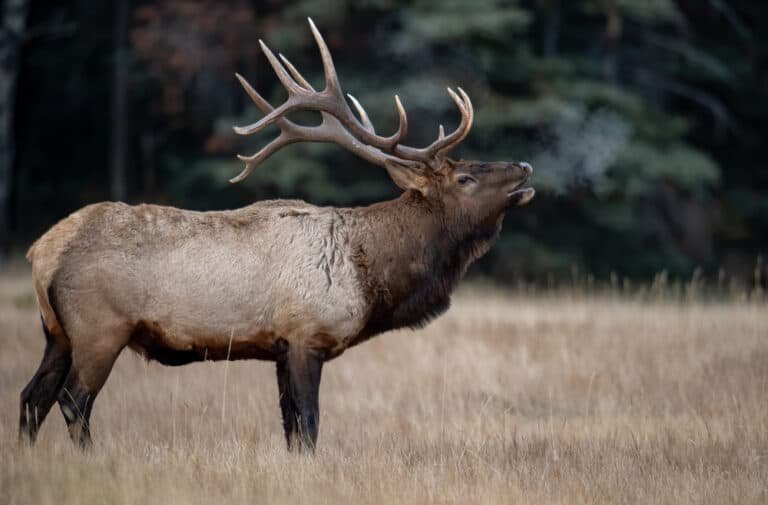Elk Archery Hunting 101: The Best Guide for Beginners
Archery Elk Hunting with a bow and arrow is an exhilarating outdoor pursuit that combines the art of archery with the challenge of tracking and outmaneuvering one of North America’s most majestic creatures. Hunting requires immense skill, patience, and a deep understanding of elk behavior and habitat preferences.
Archery elk hunting offers a unique experience that allows hunters to immerse themselves in the raw beauty of nature while putting their archery prowess to the ultimate test.
Brief Overview of Archery Elk Hunting
Archery elk hunting involves pursuing these magnificent animals on foot, typically within close range for an ethical shot with a bow. Unlike rifle hunting, archery hunting boasts its own set of distinct challenges and rewards.
Using a bow requires hunters to get closer to their quarry, necessitating stealthy movement and careful concealment amidst unforgiving landscapes. The thrill lies in stalking within range undetected, drawing back the bowstring silently, and releasing an arrow with practiced precision.
The quietness and intimacy afforded by archery make it an incredibly immersive experience; every step taken in pursuit is calculated, and every shot is executed with precision. The adrenaline rush accompanying drawing back your bow as an elk stands mere yards away is indescribable.
Understanding Elk Behavior and Habitat
To successfully hunt elk with a bow, acquiring knowledge about their behavior patterns and preferred habitats is vital. Elk are highly adaptable creatures with distinct behaviors during different seasons that savvy hunters can leverage.
Understanding the rutting season—when bulls compete for breeding rights—is crucial for locating trophy-sized bulls. Familiarizing yourself with bull elk bugling calls will aid in distinguishing mating behavior from other noises in the wilderness.
Learning to interpret this vocalization can give you valuable clues about an elk’s location and state of mind. Furthermore, comprehending their preferred habitats is key to locating elk.
Elk often inhabit diverse landscapes, from mountainous regions to open meadows and dense forests. Identifying the specific terrain features they favor for feeding, bedding, and traveling will significantly increase your chances of encountering them.
Equally important is recognizing their preferred food sources throughout different seasons, ensuring you are near their grazing areas. By obtaining comprehensive knowledge about elk behavior and habitat preferences, archery hunters can adopt strategic approaches that maximize their chances of success while respecting the instincts and patterns of these awe-inspiring creatures.
Elk Species and Their Distribution across North America
Elk, scientifically known as Cervus canadensis, are majestic ungulates that roam the vast landscapes of North America. Within this species, several subspecies exist, each with its unique characteristics.
One such subspecies is the Rocky Mountain elk (Cervus canadensis nelsoni), found predominantly in the mountainous regions of the western United States and a small portion of Canada. These elk are known for their large size, impressive antlers, and preference for open meadows in dense forests.
Another subspecies is the Roosevelt elk (Cervus canadensis roosevelti), which resides primarily along the Pacific Coast from northern California to British Columbia. Known as giants of the elk world, Roosevelt elk possess massive bodies and antlers that rival their Rocky Mountain relatives.
Their habitat includes both old-growth forests and coastal regions with abundant vegetation. We have the Tule elk (Cervus canadensis nannodes), a subspecies endemic to California’s Central Valley and nearby coastal areas.
Tule elk are adapted to marshes and grasslands but can also be found in oak woodlands. While smaller than their counterparts, they have distinctive antlers with forward-curving main beams.
To better understand these subspecies’ distribution throughout North America, range maps offer valuable insights. These maps showcase where each subspecies can be found within their habitats, helping hunters identify suitable locations for archery elk hunting adventures.
Rutting Season: Mating Behaviors, Bugling, and Aggressive Tendencies
One of the most thrilling times to pursue archery elk hunting is during rutting season when bull elks engage in intense mating rituals. This period typically occurs in late summer or early fall, varying slightly depending on the subspecies and geographic location. During the rutting season, bull elks become more vocal, using their bugling calls to attract mates and establish dominance.
Bugling is a distinctive sound that resonates through the valleys and forests, carrying for long distances. It serves multiple purposes – to attract receptive females, warn away rival males, and communicate with the herd.
The bugle consists of a high-pitched scream followed by deep guttural sounds, creating an eerie yet captivating atmosphere in the wilderness. Alongside bugling, the behavior of bull elks becomes more aggressive as they compete for mating rights.
They engage in elaborate displays of dominance by posturing, flaunting their antlers, and engaging in physical clashes with other bulls. These encounters can be visually stunning and potentially dangerous for inexperienced hunters who must exercise caution when approaching or engaging with rutting elk.
Feeding Patterns during Summer, Fall, and Winter Months
Understanding elk feeding patterns throughout different seasons is crucial for successful archery elk hunting. When abundant vegetation is available in summer, elk primarily feed on grasses found in meadows or open areas near water sources. They also browse a variety of shrubs and young tree shoots.
As autumn approaches and temperatures drop, elk shift their feeding habits to prepare for winter’s scarcity. They focus on consuming nutrient-rich plants like sedges and forbs while targeting shrubs rich in carbohydrates.
In this period leading up to winter months, when food becomes scarce due to snow cover limiting access to vegetation sources, elk may migrate from higher elevations down into valleys or forested areas where they can find sufficient sustenance. During the cold winter months, when snow-covered landscapes further limit food availability, elk rely heavily on stored fat reserves acquired during previous seasons’ feasting.
They resort to browsing on coniferous trees’ needles and bark and using their hooves to dig through the snow in search of meager food sources such as grasses and sedges. Awareness of elk’s feeding patterns throughout the year allows hunters to plan their archery elk hunting trips, positioning themselves in areas where these majestic creatures are likely to congregate during different seasons.
Gear Selection for Archery Elk Hunting
Archery equipment essentials
When it comes to archery elk hunting, selecting the right equipment is crucial for a successful and enjoyable experience. The two main types of bows commonly used are compound and traditional.
Compound bows offer several advantages over traditional bows, including increased accuracy and power. The pulley system in compound bows allows for a higher draw weight, which translates into faster arrow speeds and greater kinetic energy upon impact.
This can be especially advantageous when hunting elk, as their thick hide requires significant force to penetrate effectively. Various bow models cater specifically to archery elk hunting enthusiasts in the market.
One popular option is the Hoyt Carbon Defiant series, known for its lightweight construction and exceptional accuracy. Other notable brands, such as the Mathews Halon and Bowtech Reign series, provide reliable options with customizable features to suit individual preferences.
One key advantage of modern compound bows is their adjustable draw weights. This feature allows hunters to modify the bow’s poundage according to their skill level or physical capabilities.
For beginners or those who prefer a lighter draw weight, adjusting downwards can enhance accuracy while maintaining ample power for taking down an elk ethically. Conversely, experienced hunters can increase the draw weight to maximize arrow penetration at longer distances.
Optics for scouting elk
Scouting plays a vital role in archery elk hunting, enabling hunters to locate prime areas where elk are likely to be found. Optics such as telescopes or spotting scopes are invaluable tools, aiding in identifying distant elks and assessing their behavior without alerting them. Magnification power and field of view are critical considerations when selecting optics for scouting purposes.
A balance between these two factors is essential because high magnification often narrows the field of view while low magnification may compromise details necessary for accurate identification. Reputable brands recognized for their quality optics include Vortex, Leupold, and Swarovski.
Vortex Diamondback HD spotting scopes offer excellent value for money, with a range of magnification options and crystal-clear optics. For those seeking premium-quality optics, the Swarovski ATX/STX modular spotting scope system stands out due to its exceptional performance in low-light situations and unparalleled optical clarity.
Clothing & accessories suitable for elk hunting conditions
Elk hunting often takes place in varied weather conditions and harsh terrains. Therefore, it is crucial to have appropriate clothing and accessories to ensure comfort, safety, and optimal performance in the field. A layering system is highly recommended when dressing for elk hunting.
This method involves wearing multiple layers of clothing that can be added or removed to regulate body temperature. The base layer should consist of moisture-wicking fabric that helps keep you dry by drawing sweat away from your skin.
Mid-layers provide insulation and can be adjusted based on weather conditions. An outer layer of waterproof and breathable material protects against elements like rain or snow.
Additionally, scent control is essential to minimize detection by elk since they possess a keen sense of smell. Specialized clothing with scent-eliminating technology helps reduce human odor by trapping scent molecules, making them less likely to be detected by wary elks.
Accessories such as scent-blocking gloves, hats, and face masks further reduce human odor transmission. By carefully selecting archery equipment essentials like compound bows or traditional bows with adjustable draw weights. Or by investing in quality optics for scouting elk, and wearing appropriate clothing with a focus on scent control and layering systems, archery elk hunters can enhance their chances of success while enjoying a comfortable outdoor experience amidst nature’s beauty.
Preparation & Planning for Archery Elk Hunting Trip
Scouting techniques to locate prime hunting areas
Scouting plays a crucial role in the success of an archery elk hunting trip. To identify prime hunting areas, combining field research with proper map analysis is essential.
Start by studying topographic maps, which offer valuable information about terrain features such as ridges, valleys, and water sources. Identify potential bedding areas where elk might rest during the day and feeding grounds where they graze.
Pay attention to trails and migration patterns to understand their movement. By scouting on foot or using binoculars from elevated vantage points, you can observe elk behavior, track signs like hoof prints or droppings, and learn their preferred routes.
Utilizing topographic maps
Topographic maps are invaluable tools for archery elk hunters seeking prime hunting areas. These detailed maps provide information on elevation changes, contour lines, water bodies, vegetation types, and other key landscape features. Use contour lines to gauge steepness and identify ridge lines that can serve as vantage points for glassing elk activity in the valleys below.
Look for benches or open meadows surrounded by dense cover, which may attract feeding elk. Additionally, mark potential water sources like creeks or ponds that can act as natural magnets for these majestic creatures.
Conclusion
Embarking on an archery elk hunting trip requires meticulous preparation and planning anchored in a deep understanding of elk behavior and habitat preferences. By employing effective scouting techniques and utilizing topographic maps to their advantage, hunters can increase their chances of locating prime hunting areas frequented by these magnificent animals.
Patience is key when pursuing this challenging endeavor – success may not always come easily. Still, the journey is immensely rewarding as one immerses oneself in nature’s beauty and gains profound respect for the wild. Happy hunting!








mexico pharmacies prescription drugs: cmq mexican pharmacy online – mexican border pharmacies shipping to usa
mexico drug stores pharmacies
http://cmqpharma.com/# buying prescription drugs in mexico online
mexican mail order pharmacies
Very interesting subject, regards for putting up.Blog monry
qui quos eveniet accusamus natus amet sed. maxime et alias vero sapiente est asperiores. placeat earum perspiciatis et omnis ut. id tempora ut voluptates earum.
https://canadapharmast.com/# buy prescription drugs from canada cheap
canadian pharmacy meds: canadian pharmacy meds – canadian pharmacy meds
buying from online mexican pharmacy mexican pharmacy medication from mexico pharmacy
canadian pharmacy: canadapharmacyonline – canadian pharmacy prices
https://foruspharma.com/# mexican rx online
canadian world pharmacy canadian drugs pharmacy canadian medications
buying prescription drugs in mexico online: purple pharmacy mexico price list – mexican pharmaceuticals online
northwest canadian pharmacy: canadian pharmacy meds review – canadian drugs
india pharmacy mail order: top 10 online pharmacy in india – cheapest online pharmacy india
http://foruspharma.com/# mexican border pharmacies shipping to usa
canadian pharmacy india: canada drugs online review – canadian pharmacy 365
reputable canadian pharmacy drugs from canada canadian pharmacies online
mexican mail order pharmacies: mexico drug stores pharmacies – mexico drug stores pharmacies
п»їbest mexican online pharmacies: mexico pharmacy – medication from mexico pharmacy
pharmacy website india: indian pharmacy – reputable indian pharmacies
reputable indian online pharmacy: indianpharmacy com – online shopping pharmacy india
https://paxloviddelivery.pro/# paxlovid pill
https://ciprodelivery.pro/# ciprofloxacin generic price
http://doxycyclinedelivery.pro/# where can you buy doxycycline online
http://doxycyclinedelivery.pro/# doxycycline 100 mg order online
https://amoxildelivery.pro/# prescription for amoxicillin
http://amoxildelivery.pro/# buy amoxicillin
https://clomiddelivery.pro/# can you buy generic clomid pills
http://clomiddelivery.pro/# buy clomid without prescription
https://amoxildelivery.pro/# amoxicillin 500mg capsules uk
where to get cheap clomid without a prescription: where buy clomid online – where to get generic clomid without dr prescription